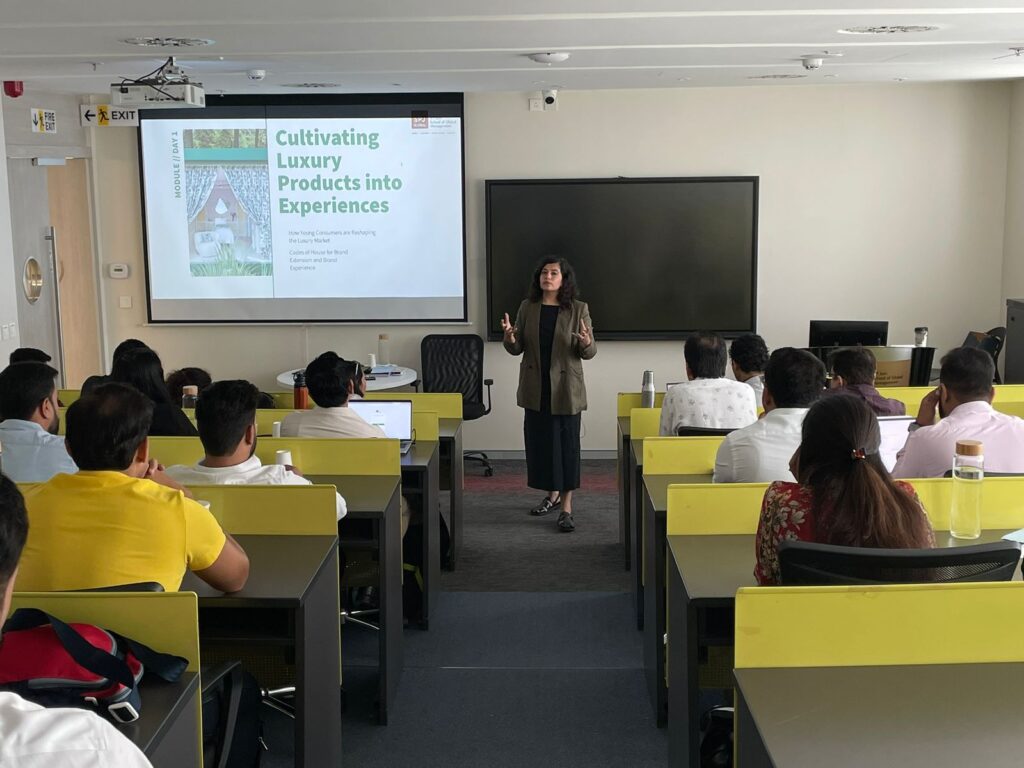Breaking into the Luxury Industry: Career Paths You Didn’t Know Existed
Gen Z has rendered the digital nomad approach of the millennials as redundant and quickly metamorphosed into the digital native moths fluttering into the far ends of the virtual world. As mentors and educators, it is our responsibility to integrate digital fulcrums into their learning to make it a safe space.
To harness the immense potential that digitalisation, sustainability and community development has to offer, it needs to be done in a more dorsal rather than superficial manner. We at Global Luxury Goods & Services Management (MGLuxM) program, offered at SP Jain School of Global Management, execute this trifecta for our students pursuing a master’s in luxury by channeling it through the curriculum, pedagogy, and assessments.

Here’s a list of career pathways that are on the rise in luxury, and were seemingly offbeat barely a few months ago:
Leveraging AI
Gucci, known for its maximalist cinematic productions that have consumed and landed the viewers into the Gucci-verse, recently, evangelised the use generative AI to create campaigns. This might not be the luxury brand’s departure from renowned photographers, meticulously recreated movie sets, and celebrity roll calls, but it indicates the growing demand for skills in roles like prompt engineers and AI visual strategists. Luxury aspirants can create a niche for themselves by honing software skills in programs like Midjourney or DALL-E to generate elevated, photorealistic visuals for creative campaigns and product imagery.
Apart from advising luxury brands on using AI as a tool to enhance, rather than replace human artistry, AI consultants also use AI tools for digital merchandising to create inspirational product bundles and personalised outfit recommendations for individual shoppers. AI supply chain specialists help luxury brands optimise logistics and inventory management for luxury goods. They help with demand forecasting to reduce overproduction and waste.
Ralph Lauren recently ushered luxury brands into AI-driven merchandising with its digital shopper plug-in – a move that has compelled the academic world to increasingly focus curriculums on the use of AI.
At MGLuxM, students are encouraged to use generative AI to create and propose immersive retail spaces, promotional calendars, influencer kits and even forecast trends that will take over the luxury space. Great powers of generative AI also call for great responsibility. As tutors, we fence the usage with tools like Turnitin, which provides the originality score of the assignment.
Focus on Sustainability
Luxury’s hedonistic nature has been on the radar of the newer crop of young mindful, conscious shoppers. Luxury goliaths like Kering, LVMH and many more have responded to this paradigm shift and speculations with the creation of special designations like Chief Sustainability Officers who monitor the impact of the brand pertaining to environment, socio-economic scenarios and prevalent cultural landscapes. While on the program, MGLuxM students dive deep into the world of luxury; they cannot be restricted to just bookish ponds and glamour. With modules like Operations and Supply Chain Management, they explore and question ways in which luxury brands across fashion, real estate, wine and spirits, hospitality and more can neutralise efficacy challenges pertaining to sustainability.
Apart from sustainable supply chains, knowledge of material innovation is also a raging skill in luxury. For instance, beauty brands are constantly on the lookout for talents that can help them revitalise brand image with environment friendly materials, sustainable manufacturing techniques, and certifications for product design.

Community Development and Management
Late Millenials and Gen Z have been known to operate in tribes, micro societies, subcultures and counter cultures. Borrowing from each other’s faith and perspectives, they extend their preferences and loyalties to brands or even choose to cancel them as herds. Today, luxury brands look for talent who value networking, choose to put themselves out there and unite like-minded people. Specially appointed community developers and managers bring the ‘triblings’ together and design strategies to keep them hooked to the brand. This role is not to be confused with the time-tested celebrity focused PR vehicle, rather it’s a more democratic approach where the brand sheds its elite cast for a more approachable and welcoming mirror.
With accelerated developments in the luxury workspace, this list seems more dynamic and might evolve sooner than you are done reading. It’s a matter of time to see what Linkedin in luxury workscape will look like in 2035. Prompt Concierge, Wardrobe Digitiser, Micro-Influencer Broker, Indie Culture Consultant? What are your thoughts?
About the Author
Ankita Brahmi is the Deputy Director of our Global Luxury Goods & Services Management (MGLuxM) program.
Recommended Reads:
Pursuing a Career in Luxury Brand Management in 2025: Key Benefits for Gen Z
My Transformational Journey at SP Jain Global: From A Student to A Luxury Brand Professional
Why Pursuing a Master’s in Luxury Brand Management Could Be Your Game Changer

